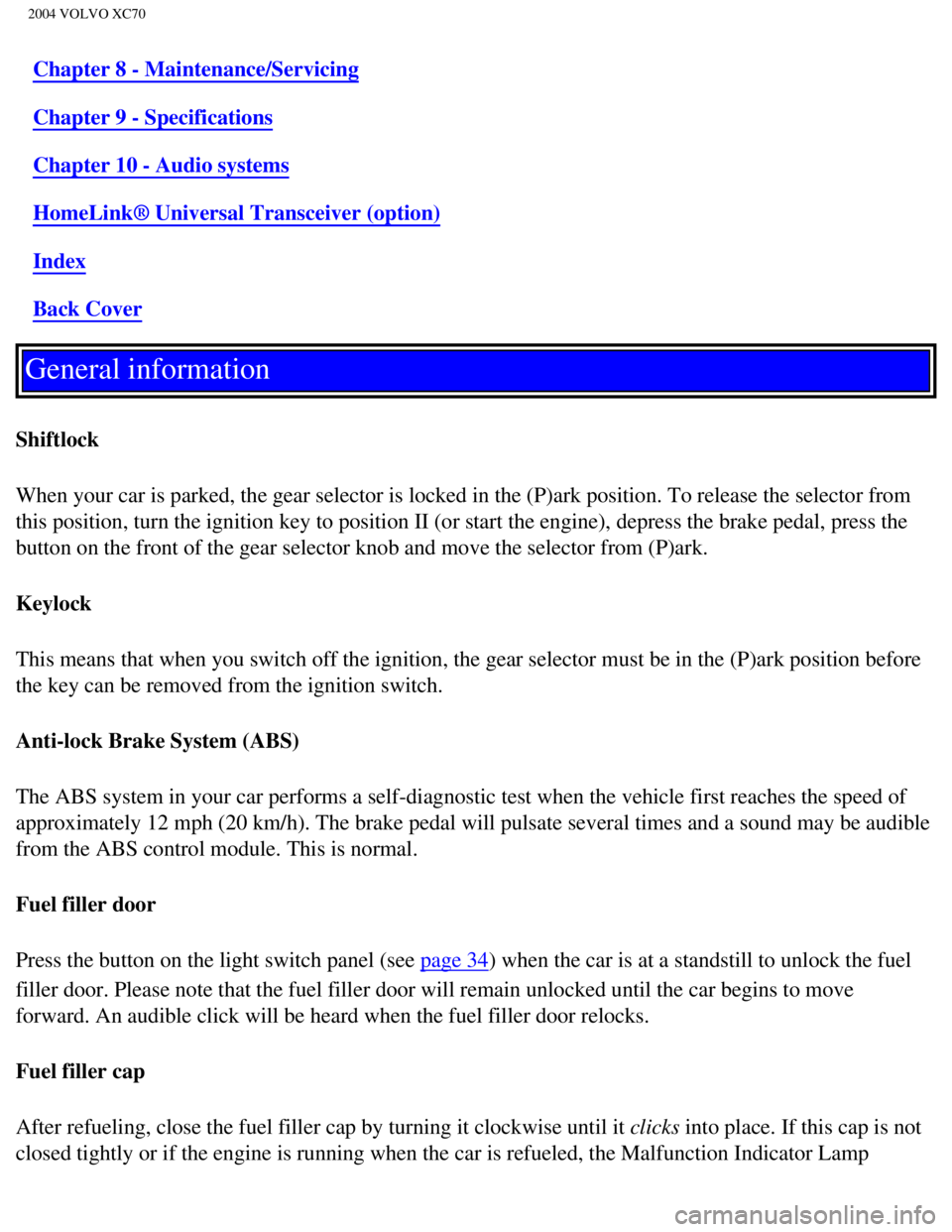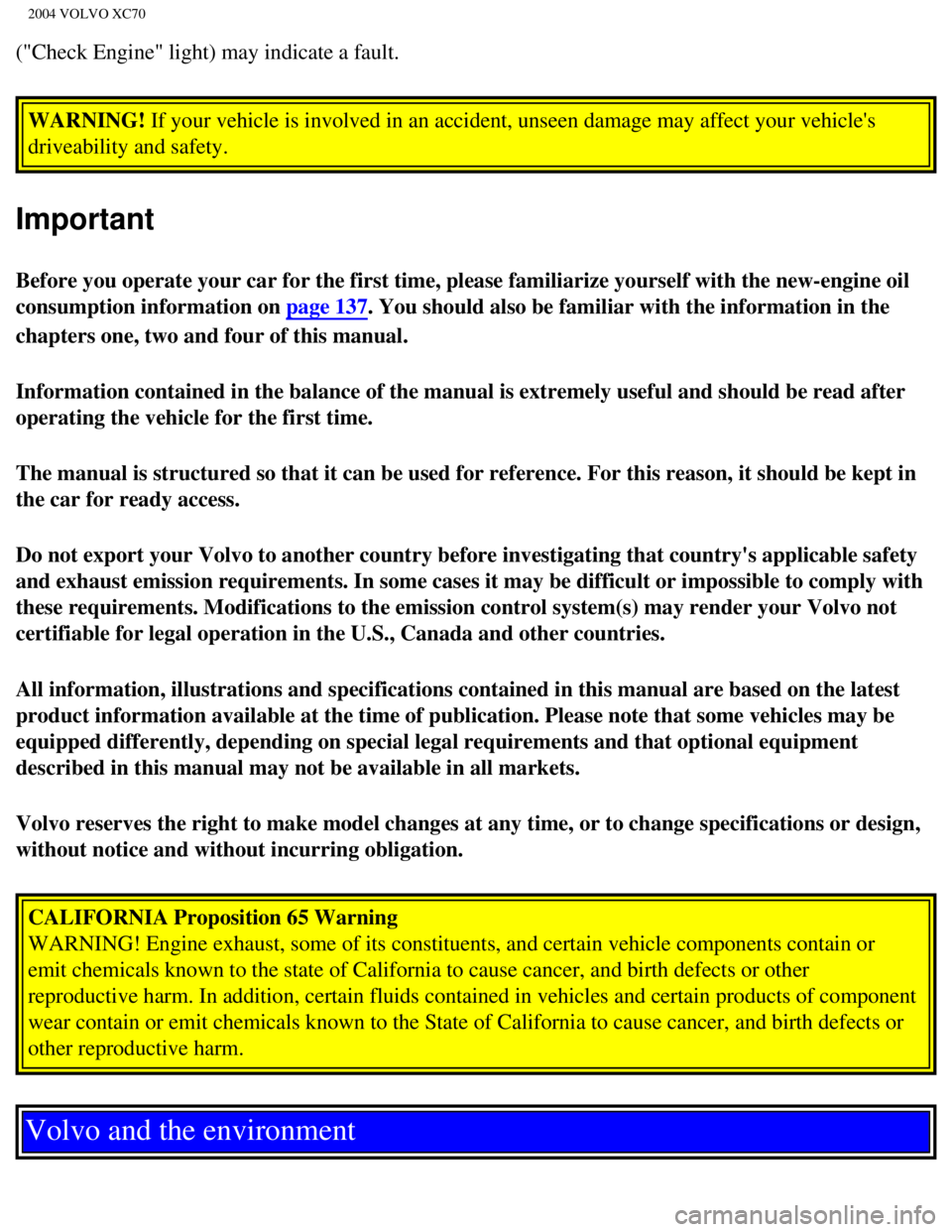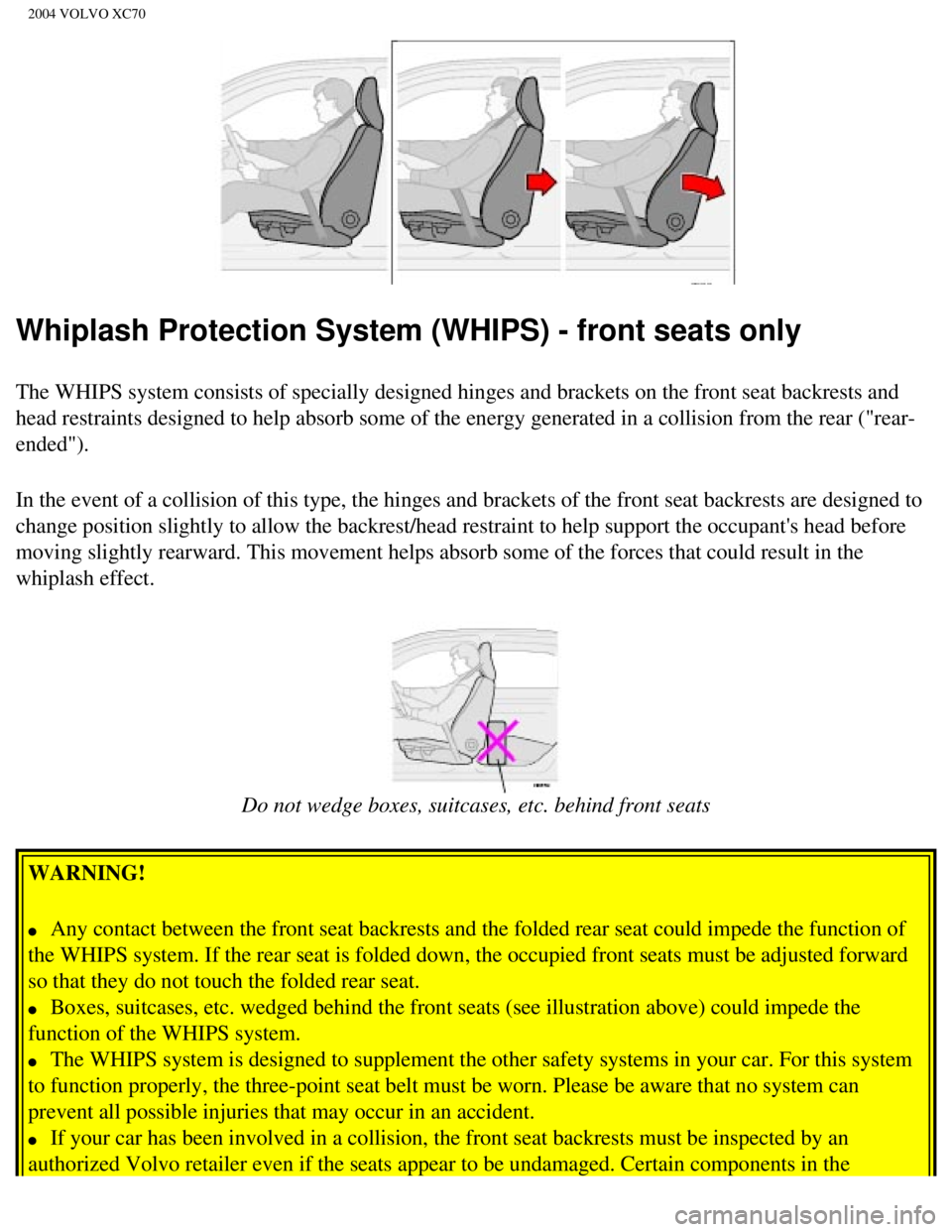light VOLVO XC70 2004 Owners Manual
[x] Cancel search | Manufacturer: VOLVO, Model Year: 2004, Model line: XC70, Model: VOLVO XC70 2004Pages: 241, PDF Size: 5.78 MB
Page 3 of 241

2004 VOLVO XC70
Chapter 8 - Maintenance/Servicing
Chapter 9 - Specifications
Chapter 10 - Audio systems
HomeLink® Universal Transceiver (option)
Index
Back Cover
General information
Shiftlock
When your car is parked, the gear selector is locked in the (P)ark pos\
ition. To release the selector from
this position, turn the ignition key to position II (or start the engin\
e), depress the brake pedal, press the
button on the front of the gear selector knob and move the selector from\
(P)ark.
Keylock
This means that when you switch off the ignition, the gear selector must\
be in the (P)ark position before
the key can be removed from the ignition switch.
Anti-lock Brake System (ABS)
The ABS system in your car performs a self-diagnostic test when the vehi\
cle first reaches the speed of
approximately 12 mph (20 km/h). The brake pedal will pulsate several t\
imes and a sound may be audible
from the ABS control module. This is normal.
Fuel filler door
Press the button on the light switch panel (see
page 34) when the car is at a standstill to unlock the fuel
filler door. Please note that the fuel filler door will remain unlocked \
until the car begins to move
forward. An audible click will be heard when the fuel filler door relock\
s.
Fuel filler cap
After refueling, close the fuel filler cap by turning it clockwise until\
it clicks into place. If this cap is not
closed tightly or if the engine is running when the car is refueled, the\
Malfunction Indicator Lamp
file:///K|/ownersdocs/2004/2004_XC70/04xc70_00.htm (3 of 6)12/30/2006 \
4:32:53 PM
Page 4 of 241

2004 VOLVO XC70
("Check Engine" light) may indicate a fault. WARNING! If your vehicle is involved in an accident, unseen damage may affect yo\
ur vehicle's
driveability and safety.
Important
Before you operate your car for the first time, please familiarize yours\
elf with the new-engine oil
consumption information on
page 137. You should also be familiar with the information in the
chapters one, two and four of this manual.
Information contained in the balance of the manual is extremely useful a\
nd should be read after
operating the vehicle for the first time.
The manual is structured so that it can be used for reference. For this \
reason, it should be kept in
the car for ready access.
Do not export your Volvo to another country before investigating that co\
untry's applicable safety
and exhaust emission requirements. In some cases it may be difficult or \
impossible to comply with
these requirements. Modifications to the emission control system(s) ma\
y render your Volvo not
certifiable for legal operation in the U.S., Canada and other countries.\
All information, illustrations and specifications contained in this manu\
al are based on the latest
product information available at the time of publication. Please note th\
at some vehicles may be
equipped differently, depending on special legal requirements and that o\
ptional equipment
described in this manual may not be available in all markets.
Volvo reserves the right to make model changes at any time, or to change\
specifications or design,
without notice and without incurring obligation.
CALIFORNIA Proposition 65 Warning
WARNING! Engine exhaust, some of its constituents, and certain vehicle c\
omponents contain or
emit chemicals known to the state of California to cause cancer, and bir\
th defects or other
reproductive harm. In addition, certain fluids contained in vehicles and\
certain products of component
wear contain or emit chemicals known to the State of California to cause\
cancer, and birth defects or
other reproductive harm.
Volvo and the environment
file:///K|/ownersdocs/2004/2004_XC70/04xc70_00.htm (4 of 6)12/30/2006 \
4:32:53 PM
Page 12 of 241

2004 VOLVO XC70
The entire process, including inflation and deflation of the airbags, ta\
kes approximately two-tenths of a
second.
WARNING!
l As its name implies, SRS is designed to be a SUPPLEMENT to -not a replac\
ement for - the three-
point belt system. For maximum protection, wear seat belts at all times.\
Be aware that no system can
prevent all possible injuries that may occur in an accident.
l When installing any optional equipment, make sure that the SRS system is\
not damaged. Do not
attempt to service any component of the SRS yourself. Attempting to do s\
o may result in serious
personal injury. If a problem arises, take your car to the nearest autho\
rized Volvo retailer for
inspection as soon as possible.
pg. 5 Front airbags - SRS
A self-diagnostic system incorporated in the sensor monitors the SRS. Th\
is system does not, however,
monitor the Side Impact Protection System (SIPS) airbags. If a fault i\
s detected, the warning light will
illuminate. The light is included in the warning/indicator light cluster\
in the instrument panel. Normally,
file:///K|/ownersdocs/2004/2004_XC70/04xc70_01a.htm (6 of 17)12/30/200\
6 4:32:54 PM
Page 13 of 241

2004 VOLVO XC70
the SRS warning lamp should light up when the ignition key is turned to \
positions I, II or III and should
go out after 7 seconds or when the engine is started. Check that this li\
ght is functioning properly every
time the car is started.
The following items are monitored by the self-diagnostic system:
l Sensor unit
l Cable harness
l Gas generator igniters
WARNING!
l Never drive an SRS equipped car with your hands on the steering wheel pa\
d / airbag housing.
l No objects, accessory equipment or stickers may be placed on, attached t\
o or installed near the
SRS cover in the center of the steering wheel, the SRS cover above the g\
love compartment or the area
affected by airbag deployment.
l If the SRS warning light stays on after the engine has started or if it \
comes on while you are
driving, drive the car to the nearest authorized Volvo retailer for insp\
ection as soon as possible.
There is no maintenance to perform on the SRS yourself. The month and ye\
ar shown on the decal on the
door pillar indicate when you should contact your Volvo retailer for spe\
cific servicing or replacement of
airbags and seat belt tensioners. This service must be performed by an a\
uthorized Volvo retailer.
Should you have any questions about the SRS system, please contact your \
authorized Volvo retailer or
Volvo Customer Support:
file:///K|/ownersdocs/2004/2004_XC70/04xc70_01a.htm (7 of 17)12/30/200\
6 4:32:54 PM
Page 22 of 241

2004 VOLVO XC70
Whiplash Protection System (WHIPS) - front seats only
The WHIPS system consists of specially designed hinges and brackets on t\
he front seat backrests and
head restraints designed to help absorb some of the energy generated in \
a collision from the rear ("rear-
ended").
In the event of a collision of this type, the hinges and brackets of the\
front seat backrests are designed to
change position slightly to allow the backrest/head restraint to help su\
pport the occupant's head before
moving slightly rearward. This movement helps absorb some of the forces \
that could result in the
whiplash effect.
Do not wedge boxes, suitcases, etc. behind front seats
WARNING!
l Any contact between the front seat backrests and the folded rear seat co\
uld impede the function of
the WHIPS system. If the rear seat is folded down, the occupied front se\
ats must be adjusted forward
so that they do not touch the folded rear seat.
l Boxes, suitcases, etc. wedged behind the front seats (see illustration \
above) could impede the
function of the WHIPS system.
l The WHIPS system is designed to supplement the other safety systems in y\
our car. For this system
to function properly, the three-point seat belt must be worn. Please be \
aware that no system can
prevent all possible injuries that may occur in an accident.
l If your car has been involved in a collision, the front seat backrests m\
ust be inspected by an
authorized Volvo retailer even if the seats appear to be undamaged. Cert\
ain components in the
file:///K|/ownersdocs/2004/2004_XC70/04xc70_01a.htm (16 of 17)12/30/20\
06 4:32:54 PM
Page 32 of 241

2004 VOLVO XC70
Check periodically that the seat belts are in good condition. Use water \
and a mild detergent for cleaning.
Check seat belt mechanism function as follows: Attach the seat belt and \
pull rapidly on the strap.
Volvo Concern for Safety
Safety is the Volvo cornerstone. Our concern dates back to 1927 when the\
first Volvo rolled off the
production line. Three-point seat belts (a Volvo invention), safety ca\
ges, and energy-absorbing impact
zones were designed into Volvo cars long before it was fashionable or re\
quired by government
regulation. We will not compromise our commitment to safety. We continue\
to seek out new safety
features and to refine those already in our cars. You can help. We would\
appreciate hearing your
suggestions about improving automobile safety. We also want to know if y\
ou ever have a safety concern
with your car. Call us in the U.S. at: 800-458-1552 or in Canada at: 800\
-663-8255.
Occupant safety
How safely you drive doesn't depend on how old you are but rather on:
l How well you see.
l Your ability to concentrate.
l How quickly you make decisions under stress to avoid an accident.
The tips listed below are suggestions to help you cope with the ever cha\
nging traffic environment.
l Never drink and drive.
l If you are taking any medication, consult your physician about its poten\
tial effects on your driving
abilities.
l Take a driver-retraining course
l Have your eyes checked regularly
l Keep your windshield and headlights clean.
l Replace wiper blades when they start to leave streaks.
l Take into account the traffic, road, and weather conditions, particularl\
y with regard to stopping
distance.
Reporting Safety Defects in the U.S.
If you believe that your vehicle has a defect which could cause a crash \
or could cause injury or death,
you should immediately inform the National Highway Traffic Safety Admini\
stration (NHTSA) in
addition to notifying Volvo Cars of North America. If NHTSA receives sim\
ilar complaints, it may open
an investigation, and if it finds that a safety defect exists in a group\
of vehicles, it may order a recall and
remedy campaign. However, NHTSA cannot become involved in individual pro\
blems between you,
your retailer, or Volvo Cars of North America. To contact NHTSA, you may\
either call the Auto Safety
Hotline toll-free at 1-800-424-9393 (or 202-366-0123 in Washington, D.C\
. area) or write to: NHTSA, U.
S. Department of Transportation, Washington D.C. 20590. You can also obt\
ain other information about
file:///K|/ownersdocs/2004/2004_XC70/04xc70_01b.htm (9 of 15)12/30/200\
6 4:32:55 PM
Page 33 of 241

2004 VOLVO XC70
motor vehicle safety from the Hotline.
Volvo strongly recommends that if your vehicle is covered under a servic\
e campaign, safety or emission
recall or similar action, it should be completed as soon as possible. Pl\
ease check with your local retailer
or Volvo Cars of North America, LLC. if your vehicle is covered under th\
ese conditions.
NHTSA can be reached at:
Internet :
http://www.nhtsa.dot.gov
Telephone:
1-888-DASH-2-DOT (1-888-327-4236) (toll free)
1-800-424-9393 (toll free)
1-202-366-0123 (in Washington DC area)
pg. 18 Brake system
Brake circuit malfunction
The brake system is a hydraulic system consisting of two master cylinder\
s and two separate brake
circuits. If a problem should occur in one of these circuits, it is stil\
l possible to stop the car with the other
brake circuit.
If the brake pedal must be depressed farther than normal and requires gr\
eater foot pressure, the stopping
distance will be longer.
A warning light in the instrument panel will light up to warn the driver\
that a fault has occurred.
If this light comes on while driving or braking, stop immediately and ch\
eck the brake fluid level in the
reservoir.
NOTE: Press the brake pedal hard and maintain pressure on the pedal - do not pump the brakes.
WARNING!
If the fluid level is below the MIN mark in the reservoir: DO NOT DRIVE.\
Tow the car to a Volvo
retailer and have the brake system inspected.
NOTE: When the car is at a standstill and the engine is idling, e.g. at a traf\
fic light and the brake pedal
is depressed, the pedal may go down slightly. This is normal and is caus\
ed by an built-in function in the
power brake system.
file:///K|/ownersdocs/2004/2004_XC70/04xc70_01b.htm (10 of 15)12/30/20\
06 4:32:55 PM
Page 34 of 241

2004 VOLVO XC70
Power brakes function only when the engine is running
The power brakes utilize vacuum pressure which is only created when the \
engine is running. Never let
the vehicle roll to a stop with the engine switched off.
If the power brakes are not working, the brake pedal must be pressed app\
roximately four times harder
than usual to make up for the lack of power assistance. This can happen \
for example when towing your
vehicle or if the engine is switched off when the vehicle is rolling. Th\
e brake pedal feels harder than
usual.
Water on brake discs and brake pads affects braking
Driving in rain and slush or passing through an automatic car wash can c\
ause water to collect on the
brake discs and pads. This will cause a delay in braking effect when the\
pedal is depressed. To avoid
such a delay when the brakes are needed, depress the pedal occasionally \
when driving through rain,
slush etc. This will remove the water from the brakes. Check that brake \
application feels normal. This
should also be done after washing or starting in very damp or cold weath\
er.
Severe strain on the brake system
The brakes will be subject to severe strain when driving in mountains or\
hilly areas or towing. Vehicle
speed is usually slower, which means that the cooling of the brakes is l\
ess efficient than when driving on
level roads. To reduce the strain on the brakes, shift into a lower gear\
and let the engine help with the
braking. Do not forget that, if you are towing a trailer, the brakes wil\
l be subjected to a greater than
normal load.
pg. 19 Anti-lock Brake System (ABS)
Anti-lock Brake System (ABS)
If the warning lamp lights up there is a malfunction of the ABS system (\
the standard braking system will
however function) and the vehicle should be driven cautiously to a Volv\
o retailer for inspection. The
Anti-lock Braking System (ABS) helps to improve vehicle control (stop\
ping and steering) during severe
braking conditions by limiting brake lockup. When the system "senses" im\
pending lockup, braking
pressure is automatically modulated in order to help prevent lockup, whi\
ch could lead to a skid.
The system performs a self-diagnostic test when the engine is started an\
d when the vehicle first
reaches a speed of approximately 12 mph (20 km/h). The brake pedal will pulsate several times and a
sound may be audible from the ABS control module. This is normal.
file:///K|/ownersdocs/2004/2004_XC70/04xc70_01b.htm (11 of 15)12/30/20\
06 4:32:55 PM
Page 35 of 241

2004 VOLVO XC70
To obtain optimal effect from the ABS system, constant pressure should b\
e kept on the brake
pedal, keep constant pressure on the brake pedal. Do not pump the brake \
pedal.
The switching of the ABS modulator will be audible and the brake pedal w\
ill pulsate during braking.
Please be aware that ABS does not increase the absolute braking potentia\
l of the vehicle. While control
will be enhanced, ABS will not shorten stopping distances on slippery su\
rfaces.
ABS with EBD (Electronic Brake Force Distribution)
EBD is an integrated part of the ABS system. EBD regulates the hydraulic\
pressure to the rear brakes to
help provide optimal braking capacity. The brake pedal will pulsate duri\
ng braking, which is normal.
If the BRAKE and ABS warning lights come on at the same time, this could\
indicate a fault in the
brake system.
l Stop the car in a suitable place and switch off the engine.
l Restart the engine.
l If both warning lights go off, no further action is required.
l If both lights are still on after the engine has been restarted, switch \
off the engine again and check the
brake fluid level (see
pages 139 and for the location of the brake fluid reservoir).
WARNING!
If the fluid level is below the MIN mark in the reservoir, DO NOT DRIVE.\
Have the car towed to an
authorized Volvo retailer and have the brake system inspected.
l If the brake fluid level is above the MIN mark, drive carefully to an au\
thorized Volvo retailer and
have the brake system inspected.
pg. 20 STC/DSTC
Stability Traction Control (STC)*/ Dynamic Stability Traction
Control (DSTC)**
* Standard on all models except the T5 turbo and R-models.
** Standard on T5 turbo and R-models, option on all other models
file:///K|/ownersdocs/2004/2004_XC70/04xc70_01b.htm (12 of 15)12/30/20\
06 4:32:55 PM
Page 37 of 241

2004 VOLVO XC70
automatically reactivated the next time the ignition is switched on. WARNING!
With AYC disabled, the car's handling and stability characteristics will\
be altered.
4. Emergency Brake Assistance (EBA)
The EBA function is an integrated part of the DSTC system. EBA is design\
ed to provide full brake
effect immediately in the event of sudden, hard braking. The system is a\
ctivated by the speed with which
you depress the brake pedal.
When the EBA system is activated, the brake pedal will go down and press\
ure in the brake system
immediately increases to the maximum level.
pg. 21 STC/DSTC
Maintain full pressure on the brake pedal in order to utilize the system\
completely. EBA is automatically
deactivated when the brake pedal is released. When the car has been park\
ed for some time, the brake
pedal may sink more than usual when the engine is started. This is norma\
l and the pedal will return to its
usual position when it is released.
The STC/DSTC button
The STC/DSTC button in the center control panel (see page 31) is used to switch the Spin Control (SC)
function on or off
NOTE: AYC (on models equipped with this function) will also be reduced, but\
not switched off, if SC
is switched off.
The button must be pressed for at least a half second to prevent SC from\
being switched off
inadvertently.
When the function has been switched off, the green indicator lamp in the\
button will go out and "STC/
DSTC SPIN CONTROL OFF" will be displayed in the text window.
All STC/DSTC functions are (re)activated each time the engine is start\
ed.
The Stability Control indicator light
file:///K|/ownersdocs/2004/2004_XC70/04xc70_01b.htm (14 of 15)12/30/20\
06 4:32:55 PM